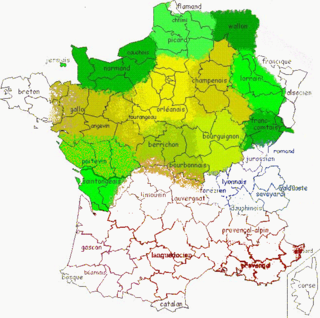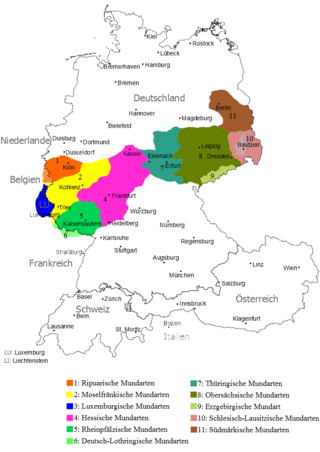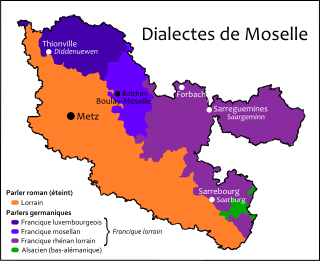The High German languages, or simply High German – not to be confused with Standard High German which is commonly also called "High German" – comprise the varieties of German spoken south of the Benrath and Uerdingen isoglosses in central and southern Germany, Austria, Liechtenstein, Switzerland, Luxembourg, and eastern Belgium, as well as in neighbouring portions of France, Italy, the Czech Republic (Bohemia), and Poland. They are also spoken in diasporas in Romania, Russia, Canada, the United States, Brazil, Argentina, Mexico, Chile, and Namibia.

Saarland is a state of Germany in the southwest of the country. With an area of 2,570 km2 (990 sq mi) and population of 990,509 in 2018, it is the smallest German state in area apart from the city-states of Berlin, Bremen, and Hamburg, and the smallest in population apart from Bremen. Saarbrücken is the state capital and largest city; other cities include Neunkirchen and Saarlouis. Saarland is mainly surrounded by the department of Moselle in France to the west and south and the neighboring state of Rhineland-Palatinate in Germany to the north and east; it also shares a small border about 8 kilometres long with the canton of Remich in Luxembourg to the northwest.

The Rhineland is a loosely defined area of Western Germany along the Rhine, chiefly its middle section, it is also the main industrial heartland of Germany because its many factories and historic ties to the Holy Roman Empire, Prussia, German Empire and etc.
Palatine German is a group of Rhine Franconian dialects spoken in the Upper Rhine Valley, roughly in the area between Zweibrücken, Kaiserslautern, Alzey, Worms, Ludwigshafen am Rhein, Mannheim, Odenwald, Heidelberg, Speyer, Landau, Wörth am Rhein and the border to Alsace and Lorraine, in France, but also beyond.

Hunsrückisch is a German dialect spoken in the Hunsrück region of Germany (Rhineland-Palatinate). This mountainous region of Germany has long been an exporter of emigrants to Brazil, United States, Canada, Australia and other parts of the world.

Ripuarian is a German dialect group, part of the West Central German language group. Together with the Moselle Franconian which includes the Luxembourgish language, Ripuarian belongs to the larger Central Franconian dialect family and also to the linguistic continuum with the Low Franconian languages.

Lorrain is a language spoken by now a minority of people in Lorraine in France, small parts of Alsace and in Gaume in Belgium. It is a langue d'oïl.

Hessian is a West Central German group of dialects of the German language in the central German state of Hesse. The dialect most similar to Hessian is Palatinate German of the Rhine Franconian sub-family. However, the Hessian dialects have some features which set them somewhat apart from other West-Central German dialects.

Moselle Franconian is a West Central German language, part of the Central Franconian languages area, that includes Luxembourgish.

Central German or Middle German is a group of High German languages spoken from the Rhineland in the west to the former eastern territories of Germany.

Lorraine Franconian is an ambiguous designation for dialects of West Central German, a group of High German dialects spoken in the Moselle department of the former northeastern French region of Lorraine.

Lorraine is a cultural and historical region in Northeastern France, now located in the administrative region of Grand Est. Its name stems from the medieval kingdom of Lotharingia, which in turn was named after either Emperor Lothair I or King Lothair II. Lorraine later was ruled as the Duchy of Lorraine before the Kingdom of France annexed it in 1766.

Rhenish Franconian or Rhine Franconian is a dialect chain of West Central German. It comprises the varieties of German spoken across the western regions of the states of Saarland, Rhineland-Palatinate, northwest Baden-Württemberg, and Hesse in Germany. It is also spoken in northeast France, in the eastern part of the département of Moselle in the Lorraine region, and in the north-west part of Bas-Rhin in Alsace. To the north, it is bounded by the Sankt Goar line which separates it from Moselle Franconian; to the south, it is bounded by the Main line which is also referred to as the Speyer line which separates it from the Upper German dialects.

Southern Germany is a region of Germany that included the areas in which Upper German dialects are spoken, which includes the stem duchies of Bavaria and Swabia in present-day Bavaria, Baden-Württemberg, and the southern portion of Hesse and Rhineland-Palatinate that were part of the Duchy of Franconia.

German dialects are the various traditional local varieties of the German language. Though varied by region, those of the southern half of Germany beneath the Benrath line are dominated by the geographical spread of the High German consonant shift, and the dialect continuum that connects German to the neighboring varieties of Low Franconian (Dutch) and Frisian.

Franconian or Frankish is a collective term traditionally used by linguists to refer to many West Germanic languages, some of which are spoken in what formed the historical core area of Francia during the Early Middle Ages.

Central or Middle Franconian refers to the following continuum of West Central German dialects:

The Vinxtbach is a stream of Rhineland-Palatinate, Germany. It is around 19 km (12 mi) long, rises south-southwest of Schalkenbach-Obervinxt and east of the Adert and discharges into the River Rhine near Rheineck Castle between Bad Breisig and Brohl-Lützing.
The Eifel dialects are those dialects spoken in the Eifel mountains of Germany. They divide into two language regions: the dialects spoken in the southern Eifel (Eifelisch) are part of the Moselle Franconian dialect group and closely resemble Luxembourgish. In the northern Eifel, by contrast, the dialects (Eifelplatt) belong to the Ripuarian dialect group and are more like Öcher Platt or Kölsch. In between there is a dialect continuum of typical transitions, whereby more or less every village speaks a little differently from its neighbours.














